|
1.
CENTRAL/ WEST AFRICA
Trade sluggish in West Africa as European market
quietens
The overall market situation has changed very little, with
trade sluggish and European buyers mostly out of the
market for the time being. There were very few small price
increases and a weakness for less favored timbers.
Sapele prices have not recovered and European buyers
have said it has been very difficult to determine current
prices for imports or for whatever landed stocks are still
available. As reported mid-month, production in West
Africa was low and there were no signs of major
producers re-starting any shut down logging or processing
activities.
Producers and exporters in the Asian region have been
holding their prices steady and have not made any real
price concessions. This has helped West African exporters
reaffirm the position that cutting prices will not stimulate
increased buying from importers who are concentrating on
downsizing their activities to match the much reduced
consumer demand.
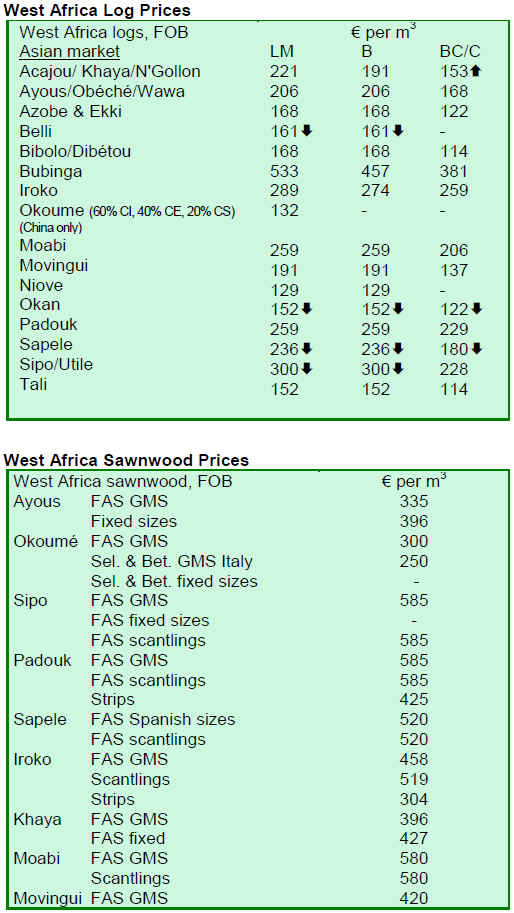
2. GHANA
Plantation Fund Management Committee inaugurated
The Forestry Commission (FC) and the Ghana Timber
Millers Organization (GTMO) have launched a sevenmember
Plantation Fund Management Committee to
generate funds for the development and finance of forest
plantations. The Committee will be responsible for
establishing its own rules of procedure, on-going forest
plantation development initiatives and ensuring plantation
forests are sustainability managed.
The Committee will be chaired by Mr. Samuel Afari-
Darty, with Msrs. Matthew Ababio, Alhassan Attah,
Robert Nyarko, Ernest Apraku, Kwaku Sampeney and
Kwaku Awauh Agyeman as members. The Committee
was inaugurated during a ceremony opened by the
Minister for Lands, Forestry and Mines, Mrs. Esther
Obeng-Dapaah, who said the Committee had become
necessary as a result of the recent high demand for
plantation timber and the increasing need for raw materials
to sustain the timber industry.
At the ceremony, it was recalled that in September 2001,
President J. A. Kufuor launched the National Forestry
Plantation Development Programme, which aimed to
establish 20,000 hectares of industrial forest plantations
annually.
WITC develops sawdust powered smoke dryer
The Wood Industries Training Center (WITC) of the
Timber Industry Development Division (TIDD) in Kumasi
has developed a smoke dryer facility that uses sawdust
instead of electricity to dry wood products. The facility is
suitable for small and medium scale enterprises (SMEs)
and marketed as affordable and easy to use. It was recently
showcased at the Ghana International Furniture and
Woodworking Industry Exhibition (GIFEX) 2008 in Accra
and is intended to reduce the costs of SMEs in a nonpolluting
and user friendly manner.
The WITC is known for its technical training activities in
the wood industry, with a primary focus on capacity
building, human resource development and institutional
strengthening. Specifically focused on supporting services
involved in downstream wood processing, the WITC has
earned a reputation over the last 12 years of being a center
of excellence for training and consultancy in the timber
industry as well as other timber-related sectors. The
Public Relations Officer of the WITC, Mr. George
Zowonu, hinted that the Center would soon change its
name to the Timber Technology Center.
In other developments, the Forest Research Institute of
Ghana (FORIG) has made significant breakthroughs in
processing coconut and palm tree waste into usable wood
for the manufacturing of various products such as tables,
chairs, cupboards and beds, a research scientist at the
Institute noted during the GIFEX 2008.
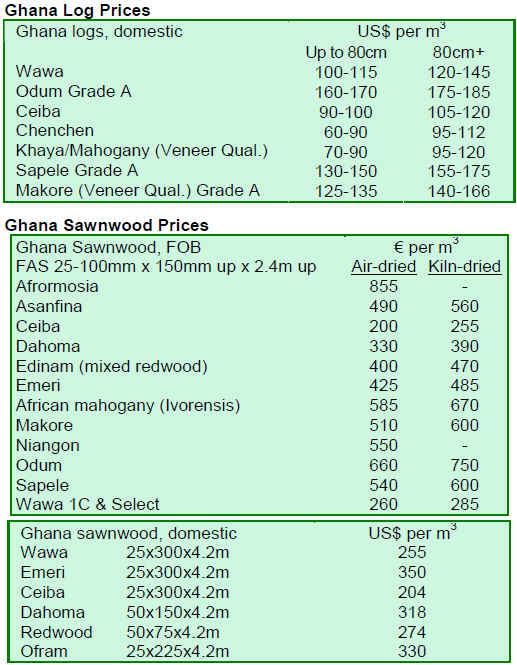
3.
MALAYSIA
SFC focuses on plantation timber projects
The Star reported that The Sarawak Forestry Corporation
(SFC) is increasing production of genetically improved
seeds to meet the heightened demand for plantation timber
products in Sarawak. Mr. Len Talif Salleh, SFC Managing
Director, indicated that the state government set a target to
establish one million hectares of planted forests by the
year 2020. Plantation forests have been seen as an
alternative and sustainable source of timber that will
relieve pressure on natural forests.
Mangroves to expand under Ninth Malaysia Plan
Bernama reported on developments geared to expand the
range of mangrove forests in Sarawak. Mangrove forests
are reported to play an important role in Sarawak¡¯s
economy and occupy 60% of 740 km coastline along the
shores and estuaries of Kuching, Sri Aman and Limbang.
The Sarawak Timber Industry Development Corporation
(STIDC) has also indicated that more than 2,000 hectares
have been identified under the Ninth Malaysia Plan as
areas where mangrove and other suitable tree species will
be planted. Tree planting awareness programmes are also
expected to be conducted under the Plan. Since 2006, over
300,000 mangrove trees of various species have been
planted in Malaysia.
EU extends EUR8 million in project finance to Malaysia
According to Business Times, the EU is providing
Malaysia nearly EUR8 million in project finance for
agriculture, environment and human capital development
in 2009. In addition, the EU is working with the European
Investment Bank to allocate another EUR1 billion for
projects in Asia. Mr. Vincent Piket, the EU Ambassador to
Malaysia, recently commented that the finance could be
linked to Malaysia¡¯s five economic corridors or could
focus on other priority sectors.
Additionally, he said the negotiation of the Forest Law
Enforcement Governance and Trade (FLEGT) Voluntary
Partnership Agreement between Malaysia and the EU was
expected to be concluded by March 2009. It is expected
that, after the signing of the VPA, Malaysia would be
given ¡®preferential access¡¯ to the EU market.
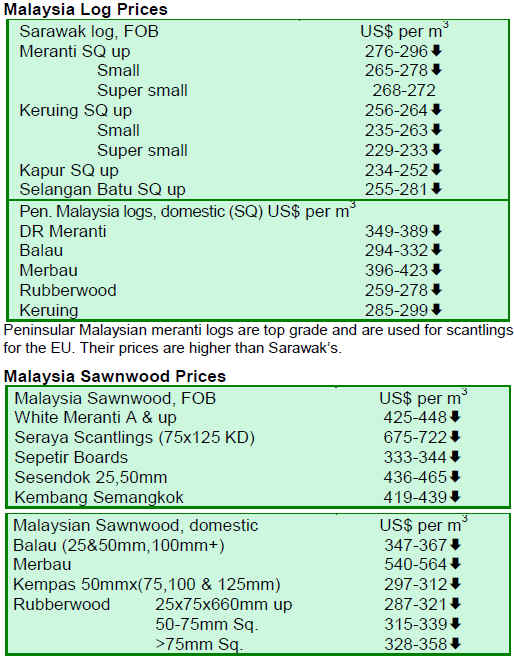
4.
INDONESIA
Significant layoffs affect Indonesia¡¯s timber sector
The Jakarta Post indicated that Riau Andalan Pulp and
Paper (Riaupulp) would be dismissing around half of its
total workforce, around 2,000 workers, in an effort to avert
financial disaster in the midst of the sector¡¯s raw material
shortage. Riaupulp Director Rudi Fajar said that the
shortage of raw materials for the pulp and paper industry
had been an issue for the past two years and were
inadequate to meet production needs. He noted that this
had been exacerbated by the current economic crisis. He
indicated that other cost saving measures had been taken,
including the reduction of fuel and electricity use, but
none had been effective in staving off the crisis. Rudi said
that only about half of normal production levels (3,000
tons v. 6,000 tons) had been sustained on a daily basis. He
expressed hoped that the government would reduce some
of the bureaucratic red tape on licensing procedures and
clarify the definition of illegal logging to help resolve the
raw material crisis.
West Sumatra regencies to benefit from sales of carbon credits
In cooperation with the Australian-based Carbon Strategic
Global (CSG), ten regencies of West Sumatra will be
compensated from the sale of their carbon credits. The
credits were generated by regencies that owned oxygenproducing,
protected forests. The plan will cover 865,560
hectares and one city in the Western Sumatran province.
The proposal was generated after CSG offered
compensation worth around USD750 million from sales of
the carbon offsets generated by the forest-owning regions
to emissions producing countries.
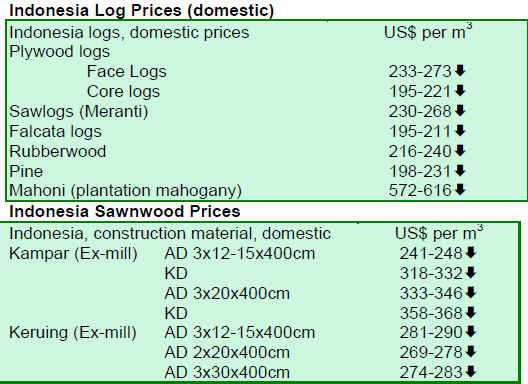
5.
MYANMAR
MTE slashes quantity of teak logs for sale
The Myanmar Timber Enterprise (MTE) has reduced the
quantity of logs in its November tender sales. The total
quantity of teak logs was 1,274 tons, compared to the
2,506 tons sold in August 2008, 2,525 tons in September
2008 and 2,041 tons in October 2008. This means the
MTE offered only about 50% of the amount sold in each
of the months of August and September. Nevertheless,
selling a smaller quantity of logs was helpful to maintain
the previous months¡¯ price levels. Additionally, the teak
logs sold this month were from prime source areas and
some major buyers supported reducing the amount of logs
sold to stabilize prices, particularly for sawing grades.
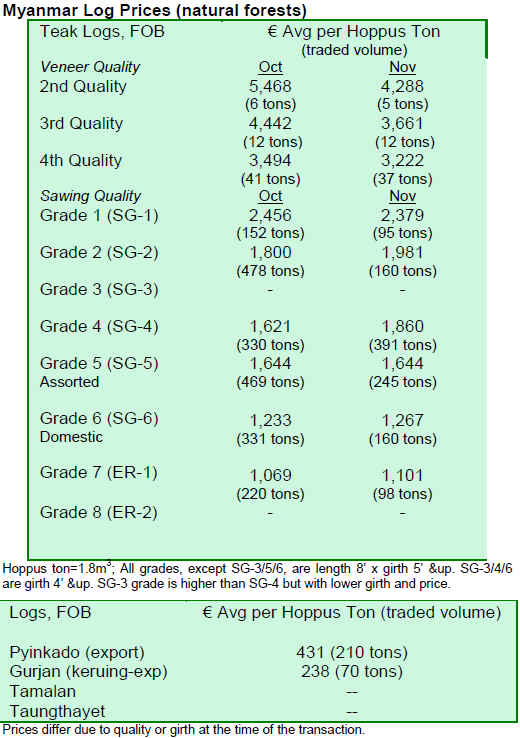
6.
BRAZIL
Uncertainty clouds 2009 outlook for furniture industry
According to Revista Amanhã, The Brazilian Association
of Furniture Companies (ABIMOVEL) has forecast a
difficult scenario for the first semester of 2009 as prices
are expected to fall. However, in the second half of the
year, a recovery is foreseen.
Despite ABIMOVEL¡¯s optimistic outlook, other
associations predict a more pessimistic scenario for the
furniture industry, with increasing input costs reducing the
profit margins of exporters. Unlike the prediction of
ABIMOVEL, the overall picture that Bento Gonçalves
Association of Furniture Companies (Sindmoveis)
foresees for 2009 is not promising. According to
Sindmoveis, growth for the furniture industry may be zero
in 2009. For the next year, the Association suggests that
companies should remain cautious about their budgets and
planning.
Controlling expenditures has been the major challenge for
the furniture industry. However, it is important that
companies invest in business management and personnel
training to sustain their businesses. In order to minimize
the effects of the global crisis, the Brazilian government
has already promised to help the sector by increasing
available credit lines. Sindmoveis believes that the dire
situation faced by the industry can be reversed with the
increase in public spending.
Timber companies face delays in securing transport
permits
According to S¨® Not¨ªcias, timber companies in the state of
Mato Grosso will initiate a lawsuit against the state
government if no action is taken in the short-term to end
the delay in issuing timber transportation permits.
Companies that are forced to delay the delivery of
products to customers in various states, and consequently
payment for services, have been seriously impacted.
Timber sales, including exports, have been harmed
because of problems in the Forest Products Trade and
Transportation System (Sisflora), an online service linked
to CCSEMA (the Registry of Forest Products Consumers)
that assists and monitors timber trade and transportation.
The delay in the issuance of such transport documents
slows down the sales and timber deliveries to customers.
The damage to date has not yet been estimated, but it is
significant.
The transport issuance process involves two institutes,
SEMA (the State Secretary of Environment) and INDEA
(the Mato Grosso Agriculture and Livestock Defense
Institute). If SEMA and INDEA fail to comply with
established procedures, timber transportation stops. The
delay in the issuance process has been generally due to the
insufficient number of public servants and the small
institutional structures. If the problems are not solved after
the expected intervention, the timber sector may initiate
lawsuits to obtain compensation for the damage caused by
the delays.
Brazil¡¯s October 2008 exports slip further
Brazil¡¯s wood products exports (except pulp and paper)
dropped further from September 2008 levels. Exports fell
21% from USD370.2 million in October 2007 to USD292
million in October 2008. The charts below show the
volume and value of Brazil¡¯s exports for October 2008
compared to the same month a year earlier:

Furniture producers eye Middle East markets
A group of 36 major furniture manufacturers in Brazil will
exhibit their products at the Index Dubai 2008 trade show
in late November 2008, reported Empreenadedor UOL.
This is the largest furniture fair in the Middle East and one
of the major furniture exhibitions in the world. The goal of
the event will enable businesses and traders to look for
new opportunities and open new markets for Brazilian
furniture. The Brazilian participation was spurred by a
project developed by the Brazilian Association of
Furniture Companies (ABIMÓVEL) in partnership with
the Brazilian Trade and Investment Promotion Agency
(APEX-Brazil).
The event will host the largest amount of the Brazilian
furniture industry participants to date. According to
ABIMÓVEL, the market for Brazilian furniture is growing
every year. It will be an opportunity to diversify target
markets for Brazilian exports and reduce its dependence
on the US market, which may continue to reduce its
imports of Brazilian furniture in the future.
Even with the housing crisis in the US, it is still the largest
single importer of Brazilian furniture. With the
depreciation of the Brazilian currency since September
2008, the furniture industry has revised its export growth
projections from 5% to 2.5% in 2008 compared to 2007,
when exports reached USD 1.1 billion.
Solidwood exports face worsening prospects
Gazeta Marcantil/Celulose Online reported that the
solidwood industry in Brazil is being crippled by the
impact of the United States housing crisis since early this
year. Official statistics indicate that exports of solidwood
products may show their worst result since 2004. The
outlook for 2009 is not optimistic because some mills have
been already closed or industrial production of some
companies has decreased dramatically.
The shrinkage of US imports has occurred since 2006. The
US share in Brazilian solidwood products exports, which
reached 42% in 2006, decreased to 30% in 2007, and in
2008 is expected to fall to 24%. In 2009, a further market
adjustment will likely occur. Many companies may phase
out their production, but capitalized mills investing in new
technology are expected to grow.
According to the Brazilian Silviculture Society (SBS), log
production from planted forests in Brazil was 156 million
m³ in 2007, and 50 million m³ from natural forests. The
total revenue of the forest sector, including charcoal and
pulp, was USD37 billion, out of which USD8 billion was
from exports. Log production was expected to be repeated
in 2008 and there was no clear forecast for 2009.
The difficulties in exporting faced by the forest sector
have been observed at least for three years due to the sharp
depreciation of the US currency. To some extent, the
domestic sales to the civil construction industry have
helped counterbalance shrinking exports.
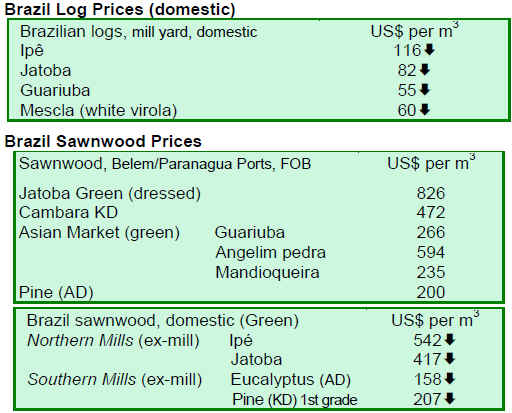
7.
PERU
Regional authorities urge Congress to reject forest law
The authorities of Loreto, Ucayali and Amazona rejected
the current version of Decree 1090, new legislation which
addresses forests, and asked Congress to delay passing the
law in order to amend it. They argued that the law does not
protect forested areas or assist with decentralization
efforts. The Regional President of Loreto noted that the
law should be revised to take into consideration human
rights or it will fail. Speaking to participants at the
National University of the Peruvian Amazon in Iquitos, he
said that the law must be delayed to propose a new
alternative law to reflect the ¡®real position of society¡¯.
Forest management to be decentralized to the regions
Media reports indicate that the Ministry of Agriculture
will decentralize Peru¡¯s forest management beginning
December 2008. Minister Carlos Leyton said the first
regional government to participate in the transfer of
authority would be San Martin, since it already has in
place the instruments to guarantee sound forest
management at the regional level. He noted that San
Martin was ready to assume authority for forest
management since the regional government already had a
forest plan and an ecological and economic zoning plan in
place, which allow the government to determine the exact
amount of forest concessions to be given. Other regions
being considered for the new decentralization scheme
include Loreto, Ucayali, Amazonas and Madre de Dios,
depending on existing conditions and legal instruments
existing in the region to provide management oversight.
The responsibility for forest management currently is
under the authority of the National Institute of Natural
Resources (INRENA).
APEC highlights importance of small and medium
industries
More than 2,000 participants from the Latin American
region and 21 Heads of State successfully concluded the
meeting of the Asia Pacific Economic Cooperation
(APEC). Issues such as the global financial crisis and the
role of women and youth in economics were addressed in
this year¡¯s conference. Additionally, one of the key items
on the agenda addressed small and medium industry issues
(PYMES) under the APEC Business Council, and a CEO
Summit was also convened.
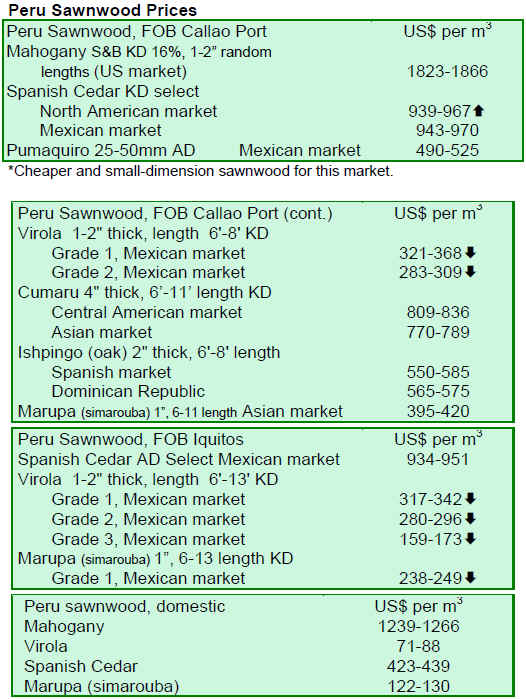
8. BOLIVIA
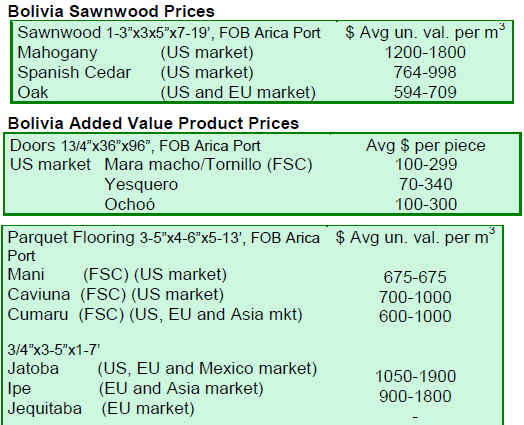
9. MEXICO
Mexico takes lead in community forest development
World Bank representative Robert Davis recently helped
launch the third stage of the Community Forestry Project
(PROCYMAF II). The project, he said, would reach out to
nearly 500 communities in Mexico covering around 3
million hectares of forests, with nearly 1 million of
certified forests included in this area. Mario Aguilar
Hernandez, the Manager of Community Forestry for the
National Forest Agency, said his institution through
PROCYMAF and ProTree, would further address
community forest work to reach nearly 80% of all forest
communities in the country. Since over 80% of the forest
area in Mexico is the property of communities and forest
common rural communities, the situation presents a
challenge for the sustainable development and
conservation of Mexico¡¯s natural resources.
10.
GUYANA
Guyana¡¯s timber products exports show rising trend
for logs
As the year-end approaches, there has been an increase in
both domestic and export prices for most products until
November 2008. Specifically, log prices have increased
for prime commercial species as well as lesser used
species.
Log prices jumped 11.5% over the average for 2007, while
sawnwood prices rose 8%, with the higher increase seen in
dressed sawnwood (11%) in 2008. The higher prices for
dressed sawn lumber drove up supply, and exporters in
Guyana have responded positively to this favorable market
condition.
Roundwood (piles, posts and poles) prices have shown the
greatest rise of all products exported over the ten month
period, with a 13% increase over average prices in 2007.
This was closely followed by plywood, which showed a
12.4% increase for the period.
With the impending log export policy that will take effect
on 1 January 2009, a spike in log exports has been seen in
this fortnight. It is expected that exports will continue for
the rest of 2008. Additionally, as the sawnwood market
remains resilient for Guyana¡¯s dressed and undressed
products, there is an indication that this will result in even
higher sawnwood exports both by value and volume in
2009.
The figure below illustrates the trend in export volumes of
the top revenue earning products (logs and lumber) for the
past four and a half months:
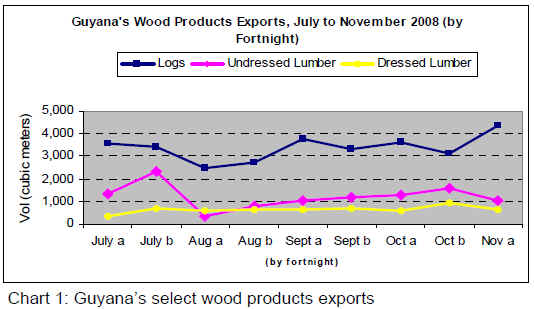
Guyana works with Canada on saw doctoring project
Guyana has collaborated with the Canadian Cooperation
Fund (CCF) in the implementation of a project aimed to
address the level of efficiency and quality of forest
products in Guyana. With the increasing call for higher
quality products in the international market, there has been
added emphasis on raising the level of efficiency of
processing in Guyana. Conversion efficiency for the subsector,
a key area that requires improvement, is being
specifically addressed under this project.
The project is being implemented in three phases with the
initial assessment having been completed on 21 November
2008. The recommendations from the assessment report
will inform the execution of the other phases of the
project, which involve providing training to the sector on
saw doctoring at the individual and regional levels. The
project is set to be completed by May 2009 with enhanced
saw doctoring skills developed by the sawmilling industry,
higher recovery rates at sawmills, and a higher quality
finished products being exported for export.

|